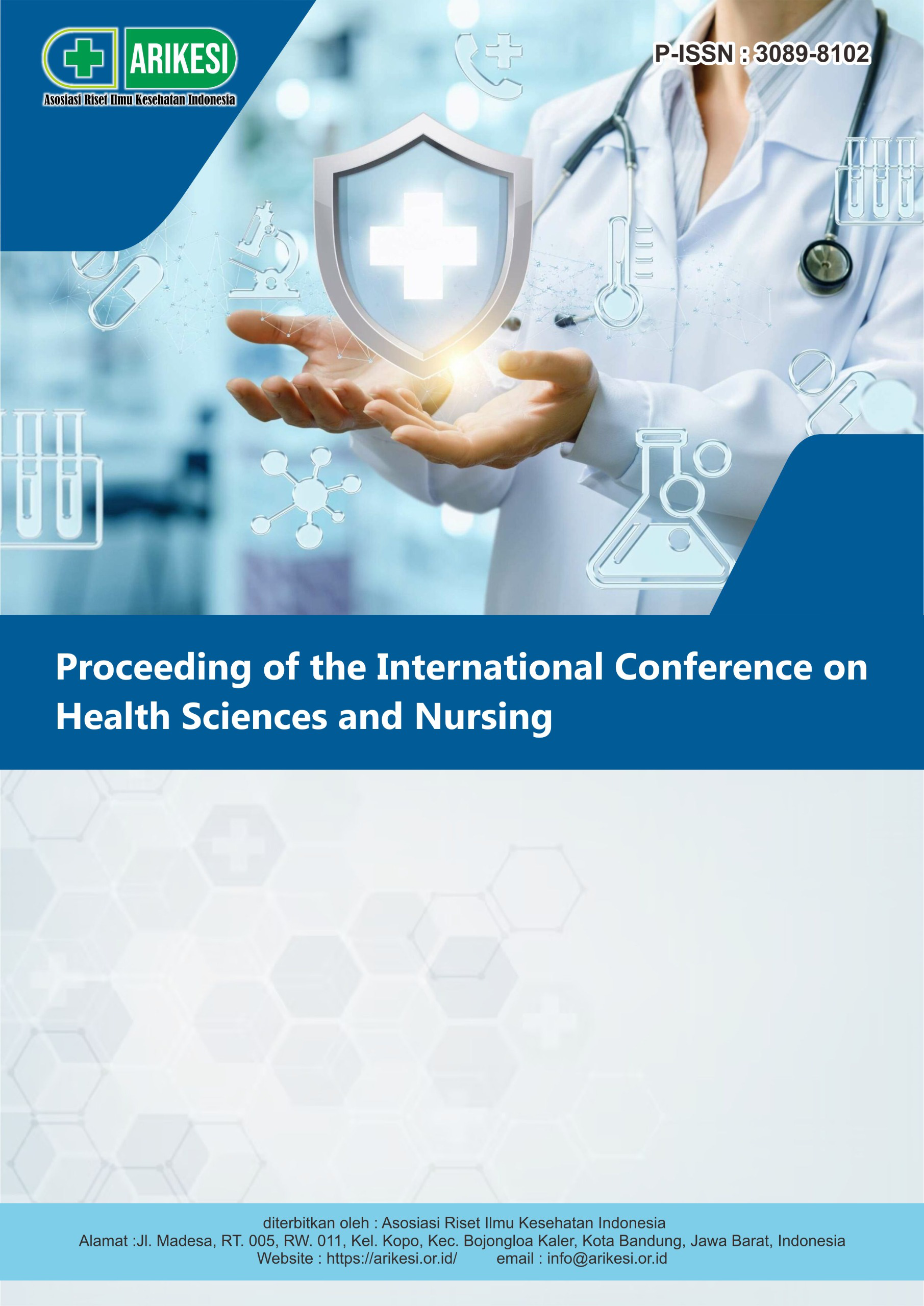Analysis of Factors Related to Stunting Incidence in Toddlers Aged 24-59 Month
Keywords:
Stunting, Toddlers, Family, NutritionalAbstract
Stunting is a critical global health issue, especially in developing countries, affecting the growth and development of children under five. This study aims to analyze the factors related to the incidence of stunting in toddlers aged 24-59 months. This quantitative research employs a cross-sectional design, involving 200 toddlers selected randomly from several integrated health posts (Posyandu). Data were collected through questionnaires and direct measurements, then analyzed using multiple logistic regression. The results showed that family nutritional awareness behavior, maternal nutritional knowledge, and clean and healthy living behavior (CHLB) significantly affect the incidence of stunting. Maternal nutritional knowledge was identified as the most dominant factor. These findings emphasize the importance of comprehensive interventions involving family education, nutritional support, and CHLB promotion to reduce stunting prevalence. Further research and implementation of targeted interventions are needed to address and mitigate stunting effectively.
Downloads
References
Asna, A. F., Erianti, M., Syah, M. N. H., & Sartika, A. N. (2023). Household food availability, maternal nutritional knowledge, and stunting in elementary students. 070001. https://doi.org/10.1063/5.0106965
Cahyani, P., & Effendy, D. S. (2024). Description of nutritional status and diet of mothers in families at risk of stunting. Miracle Journal of Public Health, 7(2), 167–175. https://doi.org/10.36566/mjph.v7i2.388
Garina, L. A., Dewi, M. K., Trusda, S. A. D., Purbaningsih, W., Muflihah, H., Tursina, A., Respati, T., & Rahimah, S. B. (2024). Maternal, child, and household risk factors for children with stunting. The Open Public Health Journal, 17(1). https://doi.org/10.2174/0118749445321448240823112908
Hasanah, U., & Arifah, S. (2024). The relationship between the implementation of clean and healthy living behaviors and the incidence of stunting in toddlers. Contagion: Scientific Periodical Journal of Public Health and Coastal Health, 6(2), 1191. https://doi.org/10.30829/contagion.v6i2.21667
Khadija, U., Mahmood, S., Annie, A., Quddoos, M. Y., Ahmad, H., Khadija, A., Zahra, S. M., & Hussain, A. (2021). Nutritional health status: Association of stunted and wasted children and their mothers. https://doi.org/10.21203/rs.3.rs-468588/v1
Koshy, B., Thilagarajan, V. V., Berkins, S., Banerjee, A., Srinivasan, M., Livingstone, R. S., Mohan, V. R., Scharf, R., Jasper, A., & Kang, G. (2025). Childhood brain morphometry in children with persistent stunting and catch-up growth. PLOS ONE, 20(2), e0306500. https://doi.org/10.1371/journal.pone.0306500
Kumari, S., & Chakravarthy, A. (2022). Assessing nutritional awareness and promoting healthy eating practices among youth. International Journal of Current Microbiology and Applied Sciences, 11(5), 306–315. https://doi.org/10.20546/ijcmas.2022.1105.034
Kurniawan, E. W., Purwanza, S. W., Satiti, I. A. D., Nurmawati, I., & Nurjihan, I. (2024). The use of Manajemen Nutrisi Balita Stunting (MNBS) smartphone application as an educational media on maternal knowledge and attitudes in preventing stunting in Geneng District Ngawi Regency. Proceeding of The International Conference of Innovation, Science, Technology, Education, Children, and Health, 4(1), 132–139. https://doi.org/10.62951/icistech.v4i1.87
Kustanto, A., Rachmat, O., & Setyadi, S. (2024). The prevalence of stunting in Indonesia: An examination of the health, socioeconomic status, and environmental determinants. Journal of Iranian Medical Council. https://doi.org/10.18502/jimc.v8i1.17062
Mahmoud, P. M., Salah Elden, H. M., Ahmed, G. F., & Lofty, A. O. (2021). Environmental enteropathy and malnutrition in pre-school stunted children. The Scientific Journal of Al-Azhar Medical Faculty, Girls, 5(2), 320–325. https://doi.org/10.4103/sjamf.sjamf_70_21
Mukodri, D. M. L., Safitri, T., Ridayani, R., Elba, F., & Siregar, N. S. A. (2023). Booklet preventing stunting based Android application (Bocesting) as a tool to enhance maternal nutritional behaviour and nutritional status. Healthcare in Low-Resource Settings. https://doi.org/10.4081/hls.2023.11982
Nurbaiti, N., Safitri, S. I., & Sari, Y. (2024). The relationship between dietary diversity and the risk of stunting in young children in Indonesia. International Journal of Health & Medical Research, 03(06). https://doi.org/10.58806/ijhmr.2024.v3i06n19
Nurhidayati, V. A., & Riyadi, H. (2022). Quality of water sources, sanitation, and hygiene in households with stunted children in rural and urban areas in West Java. Amerta Nutrition, 6(1SP), 13–18. https://doi.org/10.20473/amnt.v6i1SP.2022.13-18
Ramadhita, S., Syagata, A., & Noviani, N. (2024). The differences in maternal clean and healthy living behavior in the incidence of stunting in Yogyakarta. Indonesian Journal of Public Health Nutrition, 4(2). https://doi.org/10.7454/ijphn.v4i2.8080
Safitri, N., Cahyaningtyas, B. M. A., Putri, V. S., Dewani, L., Nugraheni, E., Nugrahanti, A. N., Saputri, M. S., & Agustin, E. W. (2025). The key to healthy and radiant skin with balanced nutrition. MAGNA MEDICA Berkala Ilmiah Kedokteran Dan Kesehatan, 12(1), 87. https://doi.org/10.26714/magnamed.12.1.2025.87-93
Sari, R. P., Husaini, H., Suhartono, E., Arifin, S., & Tri Febriana, S. K. (2024). Meta analysis: Factors relating to clean and healthy living behaviors (CHLB). Jurnal Berkala Kesehatan, 10(1), 62. https://doi.org/10.20527/jbk.v10i1.18772
Smith, A., Kininmonth, A., Tommerup, K., Boniface, D., Gericke, C., Denning, T., Summerbell, C., Vogel, C., & Llewellyn, C. (2025). The impact of deprivation and neighbourhood food environments on home food environments, parental feeding practices, and child eating behaviours, food preferences and BMI: The Family Food Experience Study-London. https://doi.org/10.1101/2025.02.07.25321815
Suri, S., & Sidiq, F. F. (2024). 50 years of research on stunting: A bibliometric analysis. Indonesian Journal of Librarianship, 1–14. https://doi.org/10.33701/ijolib.v5i1.4141
Tambunan, R. H., & Nurbaeti, E. (2024). Factors that influence stunting in the Maratua District of Berau, Indonesia. Folia Medica Indonesiana, 60(1), 78–84. https://doi.org/10.20473/fmi.v60i1.41142
Tamir, T. T., Gezhegn, S. A., Dagnew, D. T., Mekonenne, A. T., Aweke, G. T., & Lakew, A. M. (2024). Prevalence of childhood stunting and determinants in low and lower-middle income African countries: Evidence from standard demographic and health survey. PLOS ONE, 19(4), e0302212. https://doi.org/10.1371/journal.pone.0302212
Victor, C., Kupoluyi, J. A., Oyinlola, F. F., & Sule, V. O. (2025). Prevalence and factors associated with water, sanitation and hygiene (WASH) facilities deprivation among children in Nigeria. BMC Pediatrics, 25(1), 102. https://doi.org/10.1186/s12887-025-05463-5
Watson, K. M., Dasiewicz, A. S., Bassani, D. G., Chen, C.-Y., Qamar, H., O’Callaghan, K. M., & Roth, D. E. (2024). Height-age as an alternative to height-for-age z-scores to assess the effect of interventions on child linear growth in low- and middle-income countries. Current Developments in Nutrition, 8(12), 104495. https://doi.org/10.1016/j.cdnut.2024.104495
Wijaya, V. A., Arifin, S., Rahman, F., Musafaah, M., & Nugroho, A. (2024). Bibliometric analysis of research on nutrition interventions in toddlers: A focus on the role of mothers and the impact of supplementary feeding programs on stunting prevention. Malahayati Nursing Journal, 6(10), 4159–4176. https://doi.org/10.33024/mnj.v6i10.16825
Yusriadi, Y., Junus, D., Wijayanti, R., Hasnawati, H., & Cahaya, A. (2024). Perspectives of rural farmer households on food security through a qualitative study in Indonesia. African Journal of Food, Agriculture, Nutrition and Development, 24(2), 25450–25467. https://doi.org/10.18697/ajfand.127.23510







